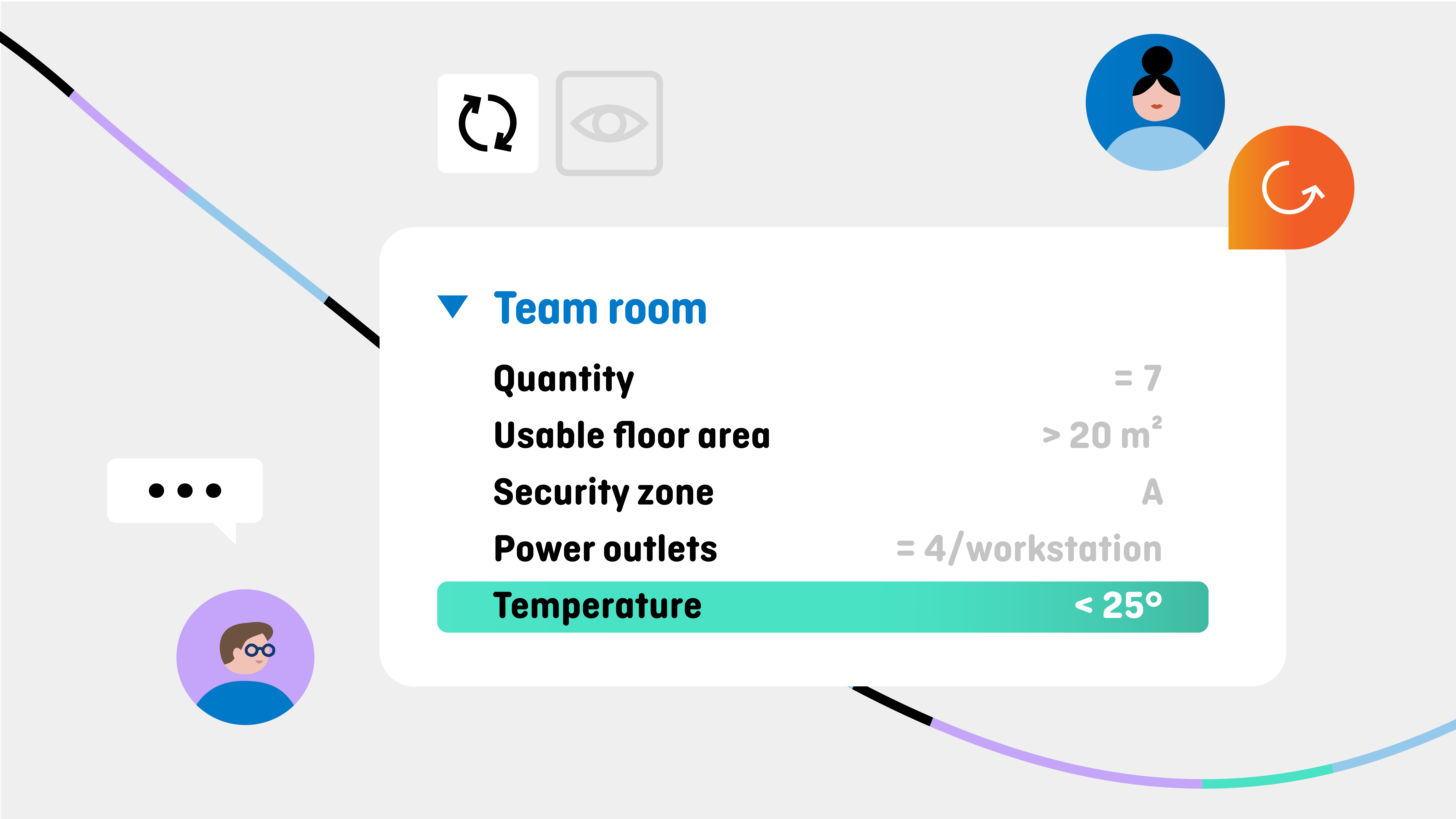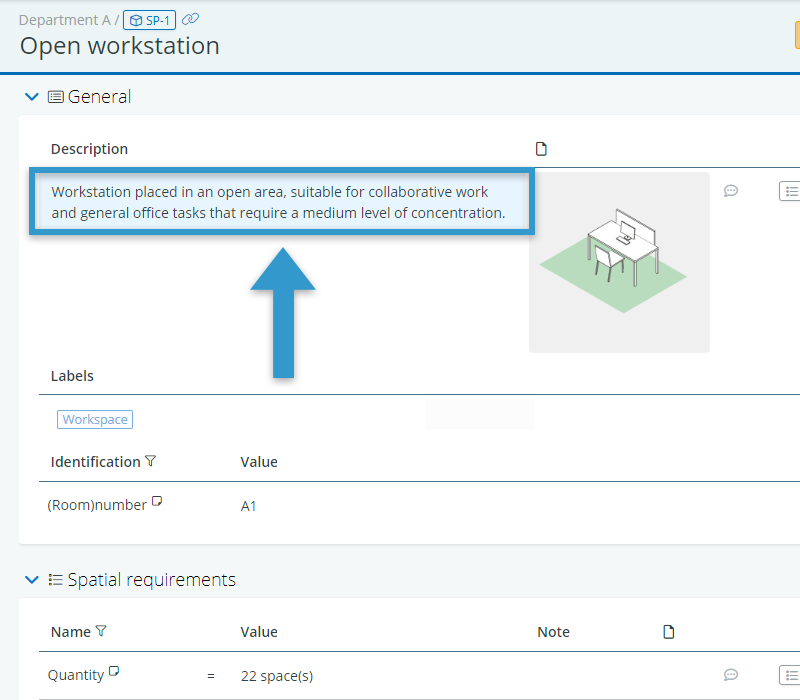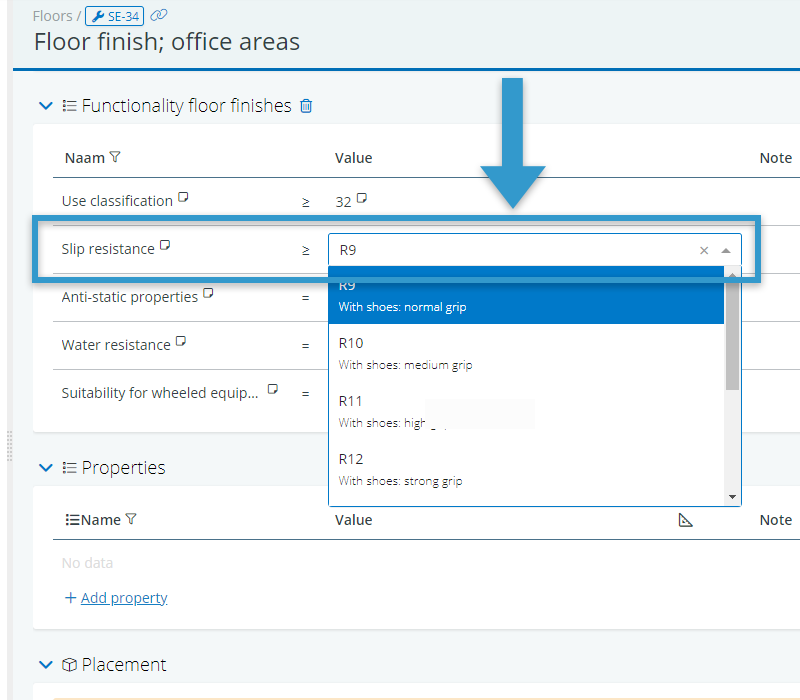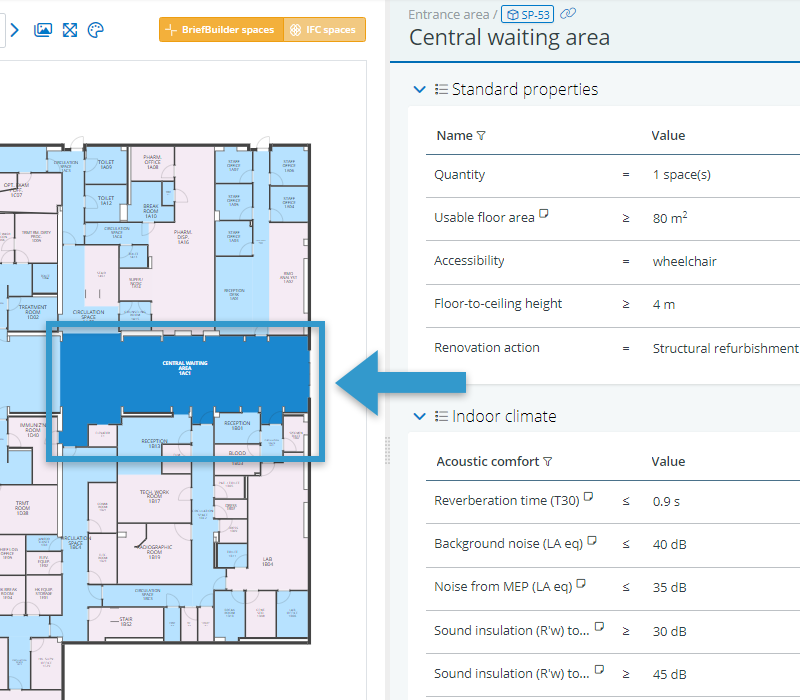
For buildings, project briefs tend to focus on spaces: what kind of spaces should the new or renovated building feature? The requirements for these spaces are usually captured in tabular overviews that are referred to as ‘room data sheets’ (RDS). In this article, we will explain in more detail what room data sheets are and how you can create them.
What is a room data sheet?
In their classic book Problem seeking: an architectural programming primer (2012), architects William Peña and Steven Parshall define room data sheets as “a means and a method to define the ‘inside’ of a space, addressing architectural, material and engineering requirements, furniture layouts and relevant equipment”.
Room data sheets are usually created during the briefing (architectural programming in the US) stages of a project to communicate the building users’ requirements for each space type. The main target group is the design team—architects, interior designers, various kinds of engineers—whose job it is to translate the RDSs into actual design solutions.
It is worth noting that the term ‘room data sheets’ is not entirely correct because it suggests that data sheets only relate to a building’s enclosed spaces (rooms), whereas in reality they can encompass open spaces (e.g. an open-plan office), outdoor spaces (e.g. a playground) and infrastructural spaces (e.g. an access road).
But that makes little difference to the central purpose, which is to systematically record all the relevant requirements per spatial entity.
What is the relevance of room data sheets?
The most important reason for creatingoom data sheets is communication. By creating a comprehensive and systematically organized set of data sheets for your project, you ensure that all participants are literally on the same page concerning what needs to be designed and delivered.
Room data sheets are also critical to ensuring that requirements are complete and consistent. By using predefined RDS templates, with standardized entry fields and picklists, clients are pushed to think systematically about the possible requirements per space, minimizing the risk of forgetting or overlooking something.

Example of a predefined picklist in BriefBuilder, which make it easier to define requirements for different spaces in a consistent way.
Equally important is the fact that room data sheets can be used for quality control during the design process. In particular when using a database solution like BriefBuilder, project teams can methodically check design proposals against the defined requirements in the RDSs (Does the room have daylight access? Check. Are there sufficient power sockets? Check. etc.).
What should a room data sheet include?
The structure and level of detail of a room data sheet can differ from project to project. For housing projects the set-up tends to be quite simple, focusing on sizes and quantities, whereas RDSs for labs and clean rooms are notoriously extensive (e.g. stipulating air tightness or the number of particles permitted per m3 of air). In general, however, an RDS covers the following subjects:
Intended use: an explanation of the space’s functional purpose.
Spatial requirements: the required number of rooms of this type and requirements concerning size and dimensions.
Security zoning: the security zone in which a space should be placed (e.g. a public or semi-public zone)
Indoor climate: quantitative requirements concerning acoustics (e.g. reverb time), thermal comfort (e.g. temperature level), visual comfort (e.g. daylight access) and air quality (e.g. fresh air per user).
Adjacencies: indication of how a space should be positioned in relation to other spaces.
Finishes: a functional indication of the space’s floor, wall and ceiling finishes (e.g. in relation to slip-resistance and ease of cleaning).
MEP elements: the mechanical elements (e.g. gas outlets), electrical elements (e.g. power outlets) and plumbing fixtures (e.g. sinks) that have to be located in a space.
Inventory/equipment: the inventory (e.g. furniture) and equipment (e.g. CT scanner) that should be placed in a space.
In addition to these topics, there may be dedicated fields for room numbers, diagrams, reference images, classifications and relevant norms and standards.

Room data sheets may include descriptive texts next to more quantitative requirements (size, temperature level etc. ) and visual data such as reference images and diagrams.
How to develop room data sheets
First of all you will need to have a list of your project’s space types. This doesn’t have to be an exhaustive list, but it should feature all the space types that are critical for the building’s functioning.
Once you have that list, you can start ‘filling in’ the requirements. Ideally, the spaces’ future occupants should be involved in this process—teachers and pupils for classrooms, nurses and patients for hospital rooms, and so on—because they will have a lot of practical knowledge about what is needed to make a space work. They can be involved by means of workshops, interviews and focus groups. This can be time-consuming, but it will provide you with lots of valuable input.
In addition, it will be useful to involve the organization’s facility management or real estate department. They will undoubtedly have plenty of practical requirements in relation to maintenance, cleaning and security.
And then there are norms and standards that can be used as input, such as internal accommodation standards (often about square metres), external standards (e.g. ISO standards concerning indoor climate), design handbooks for specific building types, and post-occupancy evaluations of other projects.
Once you have captured all the relevant requirements, it is important to have the RDSs reviewed by the project’s internal stakeholders to ensure accuracy and completeness. The design team should be involved in this as well as they are the ones who will have to work with the data.
Design verification
During the design process, there should be several verification moments (typically one per design phase) in which the client and design team systematically check whether design proposals are compliant with the defined requirements.
Different requirements should be checked in different phases. During concept design, verification should focus on basic matters such as room quantities, sizes, adjacencies and daylight access. During detail design, more technical matters such as acoustics should also be part of the verification process. And in the technical design phase, the focus can be on practical matters such as the placement of fixtures and fittings.
In this, it is important not to regard the RDS contents as set in stone. No matter how much effort you put into your room data sheets, there will always be changes. It is, for example, quite likely that the design team’s verifications will show that particular requirements are unattainable (e.g. due to budget constraints or particular technical choices). In that case requirements will need to be modified. To deal with such changes, it is advisable to set up a change management procedure in advance, making sure that all changes are assessed in relation to their impact on budget, planning and quality.

Example of verifications in BriefBuilder. For each requirement you can indicate whether it has been met or not.
Format
Traditionally, room data sheets are created in either Word or Excel—not surprising because everybody is familiar with these programs. For complex projects with lots of requirements, however, this approach will be time-consuming and error-prone as it involves a lot of manual data entry.
An alternative approach is to capture the room data sheets in a dedicated online database. This is what BriefBuilder does. By using standardized digital templates, it becomes easier to define requirements and to manage changes and verifications. Moreover, it allows you to integrate the data with the design team’s BIM tools.
Another advantage of an online database is that everybody will be working with the same data. All the spaces’ requirements are captured, analysed and managed in one place. As software engineers like to say, there is a ‘single source of truth’.
Other data sheets
In similar fashion as for rooms, you can also create data sheets for the building’s systems and elements.
Floor finishes are a good example. As mentioned earlier, you may use an RDS to define what kind of floor finish a room should have. That floor finish, however, may come with its own set of requirements—e.g. slip-resistance, ease of cleaning, recyclability, warranties, the use of non-toxic materials, and waterproofness.
For those requirements, you create dedicated data sheets, which are linked to the RDSs, but have their own specific focus.

Example of a data sheet for a floor finish.
In conclusion
Room data sheets are systematic overviews of the requirements for all of a building’s spaces. These sheets play a vital role in the successful planning and design of building projects. By clearly communicating the relevant requirements, they aid in quality control, communication, design verification and change management. As such, they play an important role in making sure the building will meet the needs of its users.
Want to know how you can easily create and manage room data sheets in BriefBuilder? We invite you to request a free trial here and/or get in touch with our experts.
RECOMMENDATIONS
Find the right level of detail: be comprehensive but avoid excessive detail. For example: it makes sense to specify the power outlets for a room, but there is probably no need to go into the specifications concerning cabling and switches.
Verify compliance: add a verification possibility for each requirement so you can use the room data sheets as a reference for verifying that the design proposals meet the defined requirements.
Manage requirement changes: establish a change management procedure to ensure that all stakeholders are aware of any modifications and their implications.
Highlight deviations: clearly mark any requirements that deviate from standard requirements as these will often demand further consideration during the design process.
Standardize: don’t reinvent the wheel with every new project. Create room data sheets that can easily be used and re-used across projects.
Integrate with BIM models: to facilitate the verification process and create a better understanding of the requirements, link the room data sheets to the design team’s BIM model.

Example of an RDS that is linked to a room in a floorplan.
